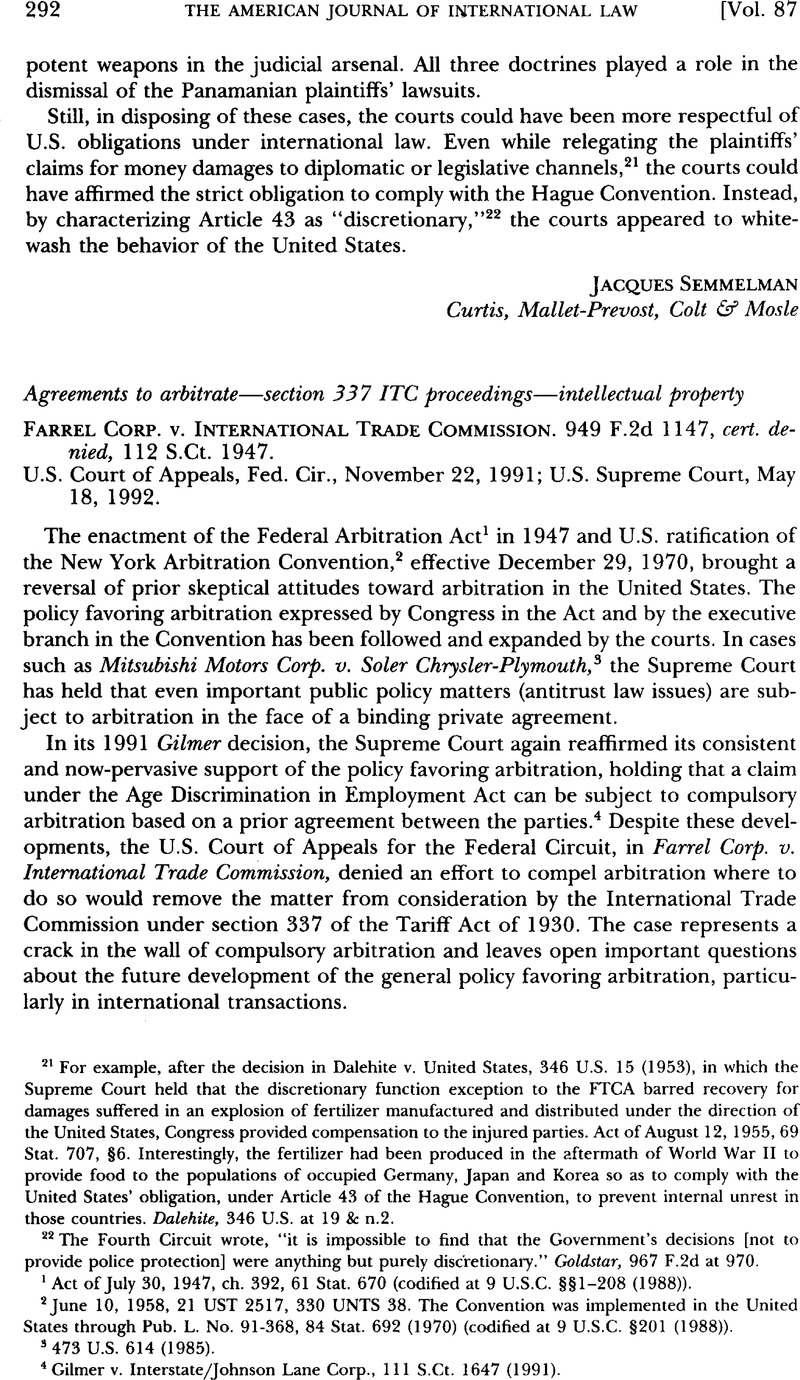No CrossRef data available.
Published online by Cambridge University Press: 27 February 2017

1 Act of July 30, 1947, ch. 392, 61 Stat. 670 (codified at 9 U.S.C. §§1-208 (1988)).
2 June 10, 1958, 21 UST 2517, 330 UNTS 38. The Convention was implemented in the United States through Pub. L. No. 91-368, 84 Stat. 692 (1970) (codified at 9 U.S.C. §201 (1988)).
3 473 U.S. 614 (1985).
4 Gilmer v. Interstate/Johnson Lane Corp., I l l S.Ct. 1647 (1991).
5 949 F.2d 1147, 1149.
6 Farrel Corp. v. Pomini, Inc., No. C88-2161A (N.D. Ohio Sept. 10, 1990), appeal dismissed (Fed. Cir. Dec. 28, 1990). A Scottish action brought by Farrel was also dismissed. Farrel, 949 F.2d at 1149 n.1.
7 U.S.I.T.C. Pub. No. 1752, Inv. No. 337-TA-213 (Final) (Sept. 1985) [hereinafter Fluidized Bed].
8 In re Certain Internal Mixing Devices and Components Thereof, Inv. No. 337-TA-317 (U.S. Int’l Trade Comm’n) (Nov. 2, 1990).
9 Id. at 8 (citing Fluidized Bed, supra note 7, at 5).
10 Id. at 6 (citing Mitsubishi, 473 U.S. at 628).
11 19 U.S.C. §1337(a)(1)(B) (1988).
12 Id. § 1337(a)(1)(A).
13 Id. §1337(b)(1).
14 949 F.2d at 1153 (quoting 1 C. Dallas Sands, Sutherland Statutory Construction 114.18, at 174 (Norman J. Singer ed., 4th ed. 1985)).
16 Id. at 1152. The court specifically declined to address “whether the ITC has authority to terminate an investigation where the complaint is withdrawn before the ITC concludes an investigation,” or “whether the ITC could terminate an investigation where the issue becomes moot.” Id. n.5. The court also refused to decide “whether the Commission may refuse to initiate an investigation on the basis of the existence of a contractual arbitration agreement between the parties.” 949 F.2d at 1153 n.6.
16 Id. at 1153.
17 The Farrel court specifically cited cases acknowledging the equitable defense of an arbitration agreement: “See, e.g., Shanferoke Coal & Supply Corp. v. Westchester Service Corp., 293 U.S. 449, 452 … (1935) (’the special defense setting up the arbitration agreement is an equitable defense’) (emphasis added); Hilti, Inc. v. Oldach, 392 F.2d 368, 371 (1st Cir. 1968) (upholding assertion of defense of arbitration).” 949 F.2d at 1153 n.7.
18 949 F.2d at 1153–54 (emphasis by court).
Clearly, a defense asserted under the “all defenses” provision would allow the Commission to find that no violation exists or to temper any relief ultimately granted, but neither the plain language of the statute nor the legislative history suggests that any defense raised should excuse the Commission from making any determination whatsoever. The report of the Senate Finance Committee states, “section 337(c) … require[s] that the Commission determine whether there is a violation of this section in each investigation it conducts.”
Id. at 1154 (citations omitted) (emphasis by court).
19 Id.
20 Young Engineers, Inc. v. U.S. Int’l Trade Comm’n, 721 F.2d 1305 (Fed. Cir. 1983).
21 949 F.2d at 1156 (quoting Gilmer, 111 S.Ct. at 1653) (emphasis by court).
22 Id. at 1156.
23 Rodriguez de Quijas v. Shearson/Am. Express, Inc., 490 U.S. 477 (1989) (claims under §12(2) of the Securities Act of 1933); Shearson/Am. Express, Inc. v. McMahon, 482 U.S. 220 (1987) (securities fraud claims under §10(b) of the Securities Exchange Act of 1934); Scherk v. Alberto-Culver Co., 417 U.S. 506 (1974) (claim of securities fraud under §10(b) of the Securities Exchange Act of 1934 and Rule 10b–5).
24 Mitsubishi, 473 U.S. 614 (1985).
25 Shearson/Am. Express, Inc. v. McMahon, 482 U.S. 220 (1987).
26 Gilmer, 111 S.Ct. 1647 (1991).